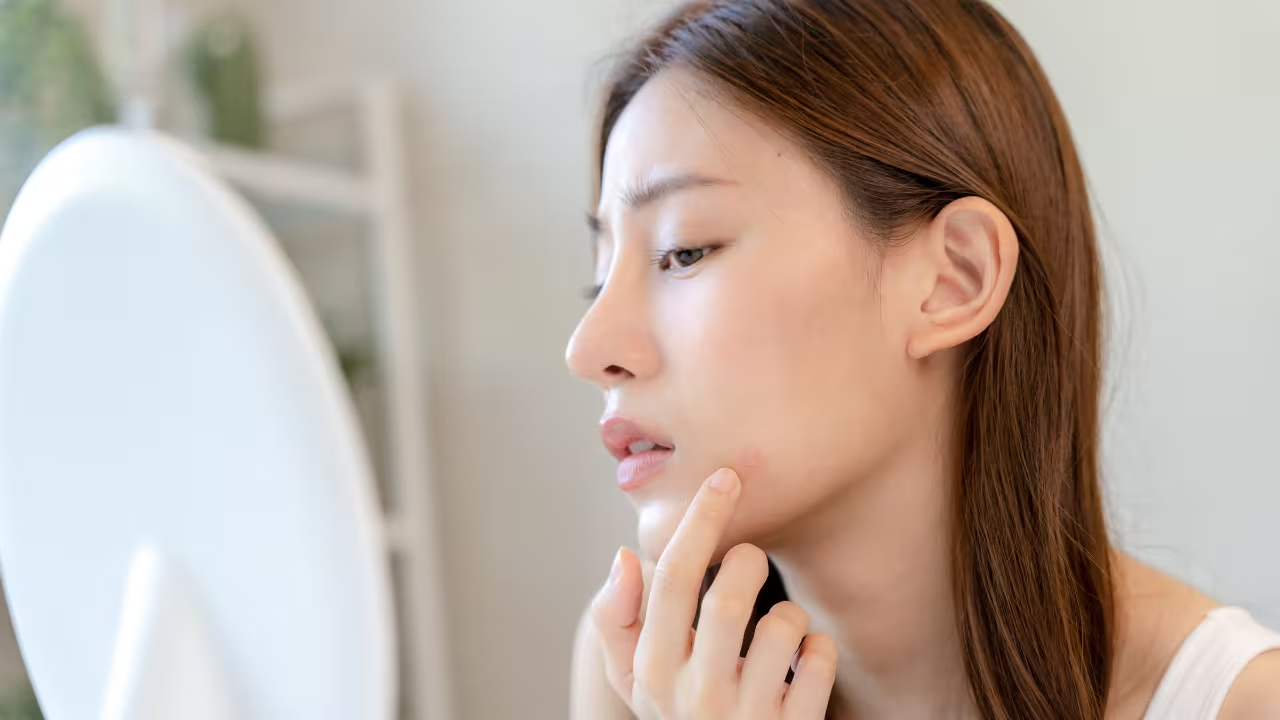Understanding Acne Scars: Types and Causes
Acne scars form when inflammation from breakouts damages the skin’s tissue, disrupting collagen production. According to MDacne, about 15% of people experience scarring after acne subsides. Scars vary in type and severity, each requiring specific treatments:
- Atrophic (Depressed) Scars: Caused by collagen loss, these include:
- Ice Pick Scars: Narrow, deep pits resembling pinpricks.
- Boxcar Scars: Wider, shallow depressions with defined edges.
- Rolling Scars: Broad, wave-like indentations with smooth edges.
- Hypertrophic or Keloid Scars: Raised scars from excess collagen, common on the chest and back.
- Post-Inflammatory HyperpigIcepick Scars: Flat, discolored marks (red, brown, or purple) that fade over months but aren’t true scars.
Factors like picking pimples, severe acne, genetics, and UV exposure worsen scarring. Healthline notes that early acne treatment and sun protection are key to preventing scars. Below, we outline 14 effective treatments to fade acne scars, starting with at-home options and progressing to professional procedures.
At-Home Treatment Options
1. Retinol/Retinoids
Retinol, a vitamin A derivative, is a dermatologist favorite for fading acne scars. CVS cites Dr. Geeta Yadav, who calls retinol a “powerhouse” for stimulating cell turnover, boosting collagen, and preventing new acne. Products like Differin Gel (0.1% adapalene, $12.99 on Amazon) reduce discoloration and improve texture.
How to Use: Apply a pea-sized amount at night, starting 2–3 times weekly to avoid irritation. Use sunscreen, as retinoids increase sun sensitivity. Best For: Hyperpigmentation, mild atrophic scars. Caution: Avoid during pregnancy; patch-test for sensitive skin.
2. Alpha Hydroxy Acids (AHAs)
AHAs like glycolic and lactic acid exfoliate dead skin, reducing discoloration and smoothing texture. Healthline highlights a 2010 study showing lactic acid peels improved scar appearance after 3 months. The Ordinary Glycolic Acid 7% Toning Solution ($8.70 on Amazon) is a budget-friendly option.
How to Use: Apply as a toner or serum 2–3 times weekly, gradually increasing use. Diluted apple cider vinegar can serve as a natural AHA. Best For: Hyperpigmentation, mild textural changes. Caution: Start with low concentrations to prevent irritation.
3. Salicylic Acid
This beta hydroxy acid (BHA) clears pores and reduces swelling, minimizing scar appearance. Allure notes salicylic acid improves hyperpigmentation and promotes new skin cells. Try Neutrogena Rapid Clear 2-in-1 Fight & Fade Toner ($12 on Amazon).
How to Use: Use as a cleanser, toner, or peel 1–2 times daily. Patch-test for sensitivity. Best For: All scar types, especially hyperpigmentation. Caution: May cause dryness; moisturize well.
4. Azelaic Acid
Azelaic acid fades hyperpigmentation by inhibiting melanin production, as per Natalie O’Neill. The Ordinary Azelaic Acid Suspension 10% ($9.80 on Amazon) is gentle and effective for sensitive skin.
How to Use: Apply morning and night after cleansing. Combine with retinoids for enhanced results. Best For: Post-inflammatory hyperpigmentation, melasma. Caution: May cause mild stinging initially.
5. Niacinamide
Niacinamide reduces inflammation and suppresses pigmentation, per Allure. Topicals Faded Brightening & Clearing Serum ($38 on Amazon) combines niacinamide with tranexamic and kojic acids for powerful scar-fading.
How to Use: Apply 1–2 times daily after cleansing, before moisturizer. Safe for all skin types. Best For: Dark spots, redness. Caution: Avoid combining with high-potency AHAs or BHAs to prevent irritation.
6. Vitamin C
Vitamin C, an antioxidant, brightens skin and reduces pigment changes. Healthline recommends stabilized formulas like SkinCeuticals C E Ferulic ($182 on Amazon) for efficacy.
How to Use: Apply morning under sunscreen for added protection. Start with lower concentrations (10–15%). Best For: Hyperpigmentation, post-inflammatory erythema. Caution: May oxidize; store in a cool, dark place.
7. Sunscreen
Daily SPF prevents scars from darkening, as UV rays worsen hyperpigmentation. NYMag cites dermatologists recommending EltaMD UV Clear SPF 46 ($41 on Amazon) for its niacinamide and lactic acid content.
How to Use: Apply SPF 30+ daily, reapplying every 2 hours outdoors. Choose mineral-based for sensitive skin. Best For: All scar types, especially hyperpigmentation. Caution: Reapply after sweating or swimming.
8. Silicone-Based Products
Silicone gels and sheets smooth textural scars by hydrating and promoting collagen production. InStyle praises Cicatricure Face & Body Scar Gel ($13 on Amazon) for acne scars.
How to Use: Apply gel 2–4 times daily or wear sheets overnight for 8–12 weeks. Best For: Hypertrophic scars, mild atrophic scars. Caution: Ensure scars are fully healed before use.
Professional Treatment Options
9. Chemical Peels
Chemical peels with salicylic, glycolic, or trichloroacetic acid remove damaged skin layers, improving texture and pigmentation. PMC notes peels are effective for hyperpigmentation and mild atrophic scars.
Procedure: Performed by a dermatologist; multiple sessions (4–6) may be needed. Best For: Hyperpigmentation, shallow boxcar scars. Cost: $100–$500 per session. Downtime: 3–7 days of redness and peeling.
10. Microneedling
Microneedling uses tiny needles to stimulate collagen, reducing scar depth. Healthline cites its safety for all skin tones, though results may take 9 months.
Procedure: 3–6 sessions, 4–6 weeks apart, by a dermatologist or esthetician. Best For: Atrophic scars (ice pick, boxcar, rolling). Cost: $200–$700 per session. Downtime: 1–3 days of redness.
11. Laser Therapy
Lasers like fractional CO2 or Er:YAG resurface skin, stimulating collagen. PMC highlights fractional lasers for their precision and reduced side effects. Nd:YAG lasers are safer for darker skin tones.
Procedure: 1–3 sessions, depending on scar severity, with a dermatologist. Best For: Atrophic scars, hyperpigmentation. Cost: $500–$2,000 per session. Downtime: 5–14 days of redness and swelling.
12. Subcision
Subcision involves a needle to release fibrous bands pulling down depressed scars, lifting the skin. Healthline notes it’s often combined with fillers for optimal results.
Procedure: 1–3 sessions by a dermatologist, under local anesthesia. Best For: Rolling scars, deep boxcar scars. Cost: $300–$1,000 per session. Downtime: 3–7 days of bruising.
13. Fillers
Hyaluronic acid or collagen fillers temporarily elevate depressed scars. PMC recommends fillers for shallow atrophic scars, requiring maintenance every 6–12 months.
Procedure: Quick injection by a dermatologist; results are immediate. Best For: Boxcar scars, rolling scars. Cost: $500–$1,500 per syringe. Downtime: Minimal; possible bruising for 1–2 days.
14. Injections for Raised Scars
Corticosteroid or 5-FU injections flatten hypertrophic and keloid scars. Healthline notes multiple sessions (every 4–6 weeks) are needed for best results.
Procedure: Administered by a dermatologist; may cause temporary discomfort. Best For: Hypertrophic scars, keloids. Cost: $100–$300 per session. Downtime: Minimal; possible skin thinning with overuse.
Combining Treatments for Optimal Results
Dermatologists often recommend combining treatments for comprehensive scar improvement. For example, Allure suggests pairing topical retinoids with in-office procedures like microneedling or lasers. A 2024 PMC review emphasizes combination therapy (e.g., subcision with fractional lasers) for atrophic scars, achieving smoother skin in fewer sessions. Always consult a board-certified dermatologist to tailor a plan based on scar type, skin tone, budget, and downtime tolerance.
Prevention: Stopping Scars Before They Form
Preventing acne scars is easier than treating them. MDacne offers these tips:
- Treat Acne Early: Use OTC or prescription treatments to control breakouts.
- Avoid Picking: Picking worsens inflammation and scarring.
- Use Sunscreen: Daily SPF prevents darkening of marks.
- Moisturize: Keep skin hydrated to support healing.
- Consult a Dermatologist: Early intervention reduces long-term damage.
Shopping Smart on Amazon
Amazon offers affordable scar-fading products, but quality varies. Tips for smart shopping:
- Check Reviews: Opt for 4-star+ products with detailed customer feedback. Look at photos for real-world results.
- Filter by Brands: Choose trusted brands like Differin, The Ordinary, or Neutrogena.
- Use Prime: Get free, fast shipping and “Try Before You Buy” for risk-free testing.
- Read Ingredients: Ensure active ingredients (e.g., retinol, niacinamide) are high on the list for potency.
- Beware of Fakes: Buy from verified sellers or Amazon’s own stock to avoid counterfeits.
For example, NBC News praises Topicals Faded Serum ($38), with editors noting visible scar lightening after 8 weeks. Check Amazon’s “Frequently Bought Together” for complementary products like sunscreens or moisturizers.
Budget and Sustainability Considerations
Scar treatments range from $10 OTC products to $2,000+ professional procedures. To save:
- Start with OTC: Try affordable options like The Ordinary or Cicatricure before investing in procedures.
- Shop Sales: Use Amazon’s “Deals & Discounts” or subscribe for recurring deliveries to save 5–15%.
- Invest Wisely: Spend on versatile products (e.g., sunscreen) or durable procedures (e.g., microneedling) for long-term value.
Sustainability-wise, choose eco-friendly brands like The Ordinary (minimal packaging) or recycle empty containers. Fashion Journal notes that mindful purchasing reduces waste, derive. Avoid over-exfoliation, as CNN Underscored warns, to prevent further skin damage.
Considerations for Skin of Color
Darker skin tones are prone to hyperpigmentation and keloid scarring. MDacne advises:
- Use gentle actives (niacinamide, azelaic acid) to avoid irritation.
- Avoid aggressive treatments like dermabrasion, which may cause discoloration.
- Opt for Nd:YAG lasers or microneedling, which are safer for melanin-rich skin.
- Test products on a small area to prevent post-inflammatory hyperpigmentation.
Final Thoughts
Fading acne scars is a journey that requires patience, consistency, and the right treatments. From affordable OTC products like retinol and niacinamide to advanced procedures like microneedling and laser therapy, the 14 options outlined above cater to various scar types and budgets. By combining at-home care with professional treatments and prioritizing prevention, you can achieve smoother, clearer skin. Amazon’s vast selection makes it easy to start your scar-fading routine, but always consult a dermatologist for personalized advice, especially for severe scarring or darker skin tones. With time and the right approach, acne scars can fade, boosting your confidence and skin health. Start your journey today, and let your skin shine.




